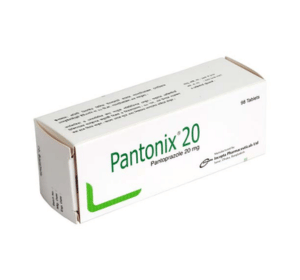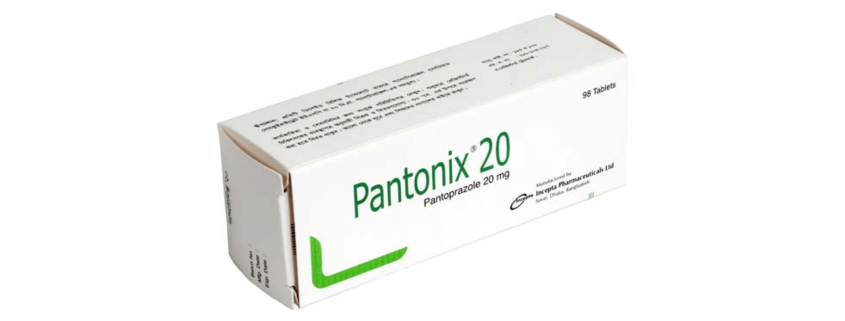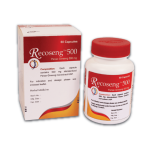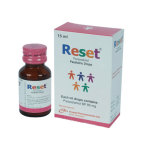Pantonix(Pantoprazole)

Therapeutic Group: Gastro Intestinal Disorders
Presentation
Pantonix 20 tablet: Each delayed release tablet contains Pantoprazole Sodium Sesquihydrate USP equivalent to Pantoprazole 20 mg.
Pantonix 40 tablet: Each delayed release tablet contains Pantoprazole Sodium Sesquihydrate USP equivalent to Pantoprazole 40 mg.
Pantonix 40 IV Injection: Each vial contains Pantoprazole Sodium Sesquihydrate USP equivalent to Pantoprazole 40 mg.
Description
Pantoprazole (Pantonix) is chemically a novel substituted benzimidazole derivative, which suppresses the final step in gastric acid production by forming a covalent bond to two sites of the H+, K+ – ATPase enzyme system at the secretory surface of the gastric parietal cell. This leads to inhibition of both basal and stimulated gastric acid secretion irrespective of the stimulus. The binding to the H+, K+ – ATPase results in duration of antisecretory effect that persists longer than 24 hours. Pantoprazole (Pantonix) is quantitatively absorbed and bioavailability does not change upon multiple dosing. Pantoprazole (Pantonix) is extensively metabolized in the liver. Almost 80% of an oral dose is excreted as metabolites in urine; the remainder is found in feces and originates from biliary secretion.
Indications
Pantoprazole (Pantonix) is indicated where suppression of acid secretion is of therapeutic benefit. Pantoprazole (Pantonix) is registered for the following indications: –
1. Peptic ulcer diseases (PUD)
2. Gastro esophageal reflux diseases (GERD)
3. Treatment of ulcer resistant to H2 receptor antagonists (H2RAs)
4. Treatment of ulcers induced by non-steroidal anti-inflammatory drugs (NSAIDs)
5. Gastrointestinal (GI) bleeding from stress or acid peptic diseases
6. Eradication of Helicobacter pylori (in combination with antibiotics)
7. Zollinger-Ellison syndrome
8. Prophylaxis for acid aspiration syndrome during induction of anaesthesia
Dosage & Administration
Delayed release tablet
The usual recommended adult oral dose is 40 mg given once daily, before breakfast. The duration of therapy is ranging from 2-8 weeks. Duodenal Ulcers: Pantonix 40 mg tablet, once daily for 2 to 4 weeks. Duodenal ulcer generally heals within 2 weeks. Gastric ulcers: Pantonix 40 mg tablet, once daily for 4 to 8 weeks. Gastric ulcer generally heals within 4 weeks. Reflux esophagitis: Pantonix 40 mg tablet, once daily for 4 to 8 weeks. Reflux esophagitis generally heals within 4 weeks of treatment. In resistant ulcers: Pantonix 40 mg tablet, once daily for 8 weeks. Ulcers induced by NSAIDs: Pantonix 40 mg tablet once daily, in patients receiving continuous treatment with NSAIDs. GI bleeding from stress or acid peptic diseases: Usual adult oral dosage, if required the dosage may be increased. Eradication of Helicobacter pylori: Triple therapy of Pantonix 40 mg twice daily in combination with appropriate antibiotic for one week achieved eradication rates of 90 to100%. Zollinger-Ellison syndrome: 4 Pantonix 40 mg tablets per day. Once control of acid secretion has been achieved, the dose should be gradually reduced to the lowest effective dose that maintains acid control. Prophylaxis for acid aspiration syndrome during induction of anaesthesia: 1 or 2 Pantonix 40 mg tablet should be given the evening before surgery and repeated again the morning of surgery.
Injection
Intravenous Pantoprazole should be replaced with oral therapy as soon as possible.
Preparation for Use
A ready-to-use solution is prepared by injecting 10 mL 0.9% Sodium Chloride Intravenous Infusion into the vial containing the dry powder. The resulting solution should be used within 12 hours and stored at 2-8°C.
After preparation, the solution should be administered over 2 to 15 minutes.
Maintenance therapy
Maintenance treatment should involve the lowest dose of the drug. Both 20 and 40 mg doses of Pantoprazole (Pantonix) are safe and effective in maintaining patients with healed reflux esophagitis and PUD in remission.
Elder patient: No problems with Pantoprazole have been encountered in clinical use in this patient group.
Side Effects
Potentially life-threatening effects: None has been reported with respect to Pantoprazole.
Severe or irreversible adverse effects: No serious adverse reactions have been described to date.
Symptomatic adverse effects: Headache (1.3%) and diarrhoea (1.5%) are the two commonest reported adverse events. It doesn\’t influence renal, cardiovascular, respiratory, endocrine, cognitive or motor functions and no consistent change have been found in any biochemical or haematological parameters. Peripheral edema has occasionally been reported in female patients. Other side effects may include abdominal pain, dizziness, nausea, epigastric discomfort, flatulence, skin rash, pruritus etc.
Precautions
Patients should be cautioned that Pantonix delayed release tablets should not be split, chewed or crushed.
Use in Pregnancy & Lactation
Pregnant women: Studies using animals have not found any risk to fetus.
Neonates & Children: No data are available on administration of Pantoprazole.
Over Dose
There are no known symptoms of overdosage in humans. Since Pantoprazole is highly protein bound, it is not readily dialyzable. Apart from symptomatic and supportive management, no specific therapy is recommended.
Commercial Pack
Pantonix 20 tablet: Each box contains 7 Alu-Alu blister strips of 14 tablets.
Pantonix 40 tablet: Each box contains 7 Alu-Alu blister strips of 14 tablets.
Pantonix 40 IV Injection: Pack of 1 vial containing 40 mg Pantoprazole accompanied by 1 ampoule of 10ml 0.9% Sodium Chloride injection BP for intravenous injection.



